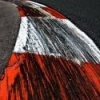But what were the real causes of the tragedy? The drivers in heat 2 had not yet finished their first lap when the tragedy took place. Campari and Borzacchini at the head of the 7-car field had passed through the North Curve, then opened the throttle along the straight leading to the next right-hand South Curve. They took this corner almost flat out at around 180 km/h. Some say the wheels of Campari's Alfa Romeo and Borzacchini’s Maserati – both monopostos – lost adhesion as the wheels slid over the sand covered oily patch, which gave no grip. On top of it both cars had slick speed track tires mounted and their front brakes removed. Both cars left the oval track over the outer retaining wall. Campari was killed instantly, Borzacchini died shortly after he was brought to the Monza Hospital. In the final race, Count Stanislas Czaykowski went also over the wall and was killed. This was terrible... inconceivable. Many motor sport followers were deeply moved by this disaster.
So – what is known now, after 73 years? Did Campari and Borzacchini really hit the sand covered oily patch or were they simply too fast for conditions? This was a short race over just 14 laps on a 4.5 km oval and therefore they might have been fighting for position early on? Were they driving 180 km/h or perhaps 190 or even more? And why did their tires loose adhesion? Why were these two leading cars carried towards the outside of the 21 degree banked turn? Yes a third car followed within seconds over the wall but its driver, Luigi Castelbarco escaped with only minor injuries and two other cars -further back- spun to the inside of that turn.
There followed a judicial investigation by the Milan Public Prosecutor with expert witnesses. What do we know about that? I am living on a small isle in the Pacific but maybe someone somewhere or in Italy knows or can find out what was written about this disaster back in 1933. It is all in your libraries. Rivista Raci, L’Auto Italiana, La Gazzetta dello Sport, Milano quotidiani...


















